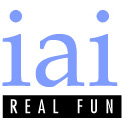|
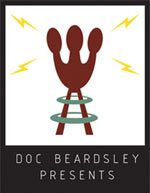
There are several different production goals within the project that span accross and incorporate a variety of different technologies. Among the technologies included in “Doc Beardsley Presents…” are the following:
Animatronics Mechanics
|
Doc’s head was designed and built during the first cycle of the project (November & December, 2000). The animatronic design has fourteen degrees of freedom and was completed using SolidWorks mechanical design software. Neck rotate, nod, and tilt functions were added during the second cycle. Upper eyelids were added third cycle. For "Doc Beardsley Presents...," the animatronic mechanics were rearranged and redesigned to fit in a new head. The animatronic functions for Doc Beardsley are as follows:
(2) Eyebrows
(2) Upper Eyelids
(2) Lower Eyelids
(2) Eye Pan
(2) Eye Tilt
(2) Smile
(1) Jaw
(1) Head Nod
(1) Head Tilt
(1) Head Rotate
| |
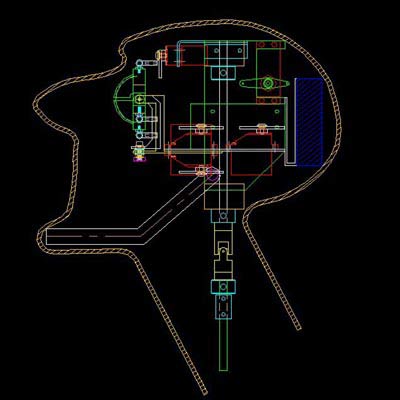
|
iSPS
The Interactive Show Puppeteering System (iSPS) affords production of animations via using convention puppeteering techniques that can be directly translated in real time to the Animatronic mechanics and then recorded for future play back.
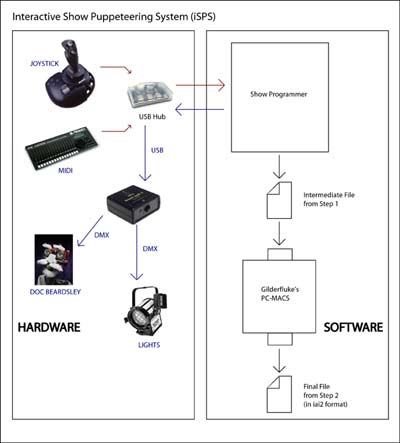
|
|
The hardware used for the iSPS unput is commercially available: Microsoft Sidewinder joysticks, a Peavey 1600x Midi console, USB hubs, and a SmartJack USB-DMX converter. A hand puppet device [not pictured] is being developed for the iSPS using pieces from a basic Sidewinder joystick.
iSPS will have an interface for puppeteers to map the different joystick button and motions, MIDI sliders and buttons, and the crunch mouth to different functions. The puppeteer will be able to map different motions and functions to various sliders and buttons so that puppeteering these physical robots will be as physical and intuitive as marionettes.
|
|
Showsmith
Showsmith is a complete software and hardware package for authoring and automating the execution of an nonlinear interactive experience. Interactive experiences can include two major components: show (passive) and interactive activities.
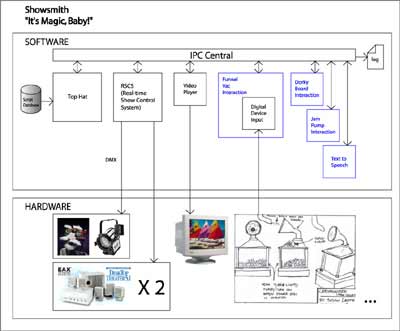
|
|
For the show element, an integral part of Showsmith, known as iSPS (Interactive Show Puppeteering System), can be used to program shows that are driven by DMX, a light control protocol. If a device can accept DMX signal, it can be programmed by iSPS. Some examples of such shows include lighting shows and animatronics animation. In addition, Showsmith uses surround sound technology extensively, since the use of audio is often instrumental in creating an engaging show.
For the interactivity of the experience, the system is capable of receiving digital input as keyboard input, allowing a variety of input devices such as buttons, switches, etc. to be used as interactive devices in the experience. A simple example of such interaction could be that when a guest pushes a button, it triggers a light show that was programmed using iSPS, with a sound clip playing simultaneously in the background.
|
The purpose of Showsmith is to shorten the development time and simplify the process in creating interactive experiences without compromising the creativity and fun factor of the experiences. Anyone should be able to create generic experiences using Showsmith, but to harness the true power of Showsmith, some knowledge in C/C++ programming is required.
Major Components
IPC – Inter Process Communication, an open-source software package developed at the Robotics Institute of Carnegie Mellon University, is a message-relaying system that assists in the communication of different components of a software that may be residing on different machines connected to a network. It is a message-subscription system.
Interactive Device Input – Showsmith comes with a keyboard encoder made by Hagstrom Electronics. This is a board that is capable of accepting digital input and converts it to keyboard input. All interactive devices created for the experience should be connected to this board. Microsoft’s DirectX’s DirectInput is used to handle the keyboard input on the software side.
|
Script Action Web – One can write a script for the interactive experience to serve the purpose of narratives. The script is constructed in the form of a directed acyclic graph that is stored in a Microsoft Access database. The flow of the experience need not be linear. Branches are encouraged to create non-linear experiences. Logically, the script spans out like a web.
Video Player – This component receives commands from Top Hat through IPC and plays a video clip as specified. It can play MPEG or AVI files.
RSCS – Real-time Show Control System receives commands from Top Hat to send data to hardware. It uses Color Kinetics’ USB-to-DMX hardware and software to sent out DMX signals to any device that takes DMX data. RSCS can either generate DMX data dynamically or read them in from files. DMX signal data can be stored as files (for pre-scripted shows) using iSPS (please see the technical specifications of iSPS for more details), and RSCS can open those files during run-time upon requests from Top Hat and deliver the data to DMX hardware. Also, using Direct Audio from Microsoft’s DirectX 8, it can play audio using surround sound technology (with adequate hardware).
| |
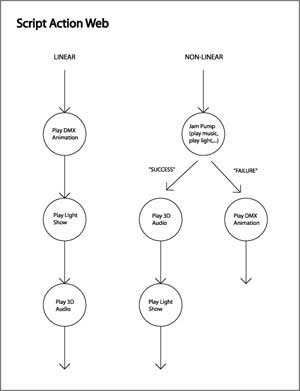
|
Top Hat – This component of Showsmith is the brain of the system. It is capable of reading in a Script Action Web for an experience and executing it. It also takes input from the Interactive Device Input and decides what to do next in real-time (based on the script). For example, it can tell RSCS to play a DMX animation or tell Video Player to play an MPEG file based on guests’ input and what is specified in the script.
Expansibility and Extensibility
The strength of Showsmith lies in the fact that it can be expanded and extended. The architecture of the system allows more components to be added without affecting the existing components. When one needs to add a new component to the system, s/he simply needs to define the IPC messages that will be used by the new component to communicate with the rest of the system. In most cases, the new component would only need to communicate with Top Hat, since it is the component that decides what to do next in an experience. In addition, one also needs to extend the capability of Top Hat to handle the new functions introduced by the new component.
|
